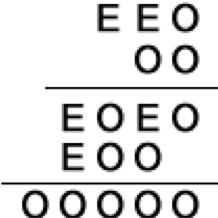Problems
Decipher the following puzzle. All the numbers indicated by the letter E, are even (not necessarily equal); all the numbers indicated by the letter O are odd (also not necessarily equal).

Determine all integer solutions of the equation \(yk = x^2 + x\). Where \(k\) is an integer greater than \(1\).
\(f(x)\) is an increasing function defined on the interval \([0, 1]\). It is known that the range of its values belongs to the interval \([0, 1]\). Prove that, for any natural \(N\), the graph of the function can be covered by \(N\) rectangles whose sides are parallel to the coordinate axes so that the area of each is \(1/N^2\). (In a rectangle we include its interior points and the points of its boundary).
a) Give an example of a positive number \(a\) such that \(\{a\} + \{1 / a\} = 1\).
b) Can such an \(a\) be a rational number?
For which natural \(n\) does the number \(\frac{n^2}{1.001^n}\) reach its maximum value?
The function \(F\) is given on the whole real axis, and for each \(x\) the equality holds: \(F (x + 1) F (x) + F (x + 1) + 1 = 0\).
Prove that the function \(F\) can not be continuous.
Two players in turn increase a natural number in such a way that at each increase the difference between the new and old values of the number is greater than zero, but less than the old value. The initial value of the number is 2. The winner is the one who can create the number 1987. Who wins with the correct strategy: the first player or his partner?
In a certain kingdom there were 32 knights. Some of them were vassals of others (a vassal can have only one suzerain, and the suzerain is always richer than his vassal). A knight with at least four vassals is given the title of Baron. What is the largest number of barons that can exist under these conditions?
(In the kingdom the following law is enacted: “the vassal of my vassal is not my vassal”).
Two play tic-tac-toe on a \(10 \times 10\) board according to the following rules. First they fill the whole board with noughts and crosses, putting them in turn (the first player puts crosses, their partner – noughts). Then two numbers are counted: \(K\) is the number of five consecutively standing crosses and \(H\) is the number of five consecutively standing zeros. (Five, standing horizontally, vertically and parallel to the diagonal are counted, if there are six crosses in a row, this gives two fives, if there are seven, then three, etc.). The number \(K-H\) is considered to be the winnings of the first player (the losses of the second).
a) Does the first player have a winning strategy?
b) Does the first player have a non-losing strategy?
a) Could an additional \(6\) digits be added to any \(6\)-digit number starting with a \(5\), so that the \(12\)-digit number obtained is a complete square?
b) The same question but for a number starting with a \(1\).
c) Find for each \(n\) the smallest \(k = k (n)\) such that to each \(n\)-digit number you can assign \(k\) more digits so that the resulting \((n + k)\)-digit number is a complete square.